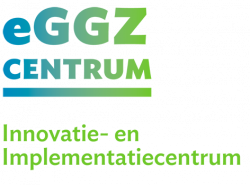Funded twice with ERDF (EFRO Kansen voor West) (Total: €1.814.997,-)
Funded twice with ERDF (EFRO Kansen voor West) (Total: €1.814.997,-)

Funded twice with ERDF (EFRO Kansen voor West) (Total: €1.814.997,-)
Funded twice with ERDF (EFRO Kansen voor West) (Total: €1.814.997,-)
The demand for mental health care is increasing. As a result costs are rising, but governments have to reduce health care spending. At the same time citizens demand more tools for managing their own (mental) health.
The eGGZ Centre-project contributes in solving these challenges by using an integrated approach; high quality and evidence-based products.
The centre is a knowledge platform for prevention and self-help in mental healthcare. Self-help in mental health care cannot be achieved without proper scientific testing.
Therefore the platform combines efforts of universities, mental health institutions and the end-users.
eMental Health (apps and virtual reality) is an important solution, because it contributes to cost-reduction and at the same time guarantee accessibility to health care for all EU-citizens.
Stichting Arq, VuMC, AMC, Interapy Nederland, IJsfontein, Little Chicken Game Company, CLeVR, GGZ Noord-Holland-Noord, Motekforce Link, GGD Amsterdam
Startconferentie eGGZ Centrum op 16 februari 2017 -
https://www.arq.org/nl/nieuws/save-date-startconferentie-eggz-centrum-op-16-februari?position=0&list=p3pWvRKst8JV8iadZJQxWtS8diF1Zyny0s_pkm1S3QA
Get notified about new updates, opportunities or events that match your interests.

The pioneering innovations were presented of the Scale Up Future-proof artificial turf pitches project, a collaboration between Amsterdam and Haarlem focused on sustainable artificial turf pitches. Over the next few years, more than 250 sports pitches in both cities will be transformed into circular, energy-generating and climate-adaptive sports venues. These artificial turf pitches can not only generate and store energy, but also involve smart water management. An approach that is globally relevant for urban sports infrastructure.
Three consortia collaborate on the sport pitch of the future
The three selected consortia Antea Sport, EnergieVeld and GOO4iT together comprise more than 15 market players. They join forces within this innovation partnership, where there is room for long-term collaboration, co-creation and scalable innovation. The pioneering solutions will make it possible to cool down sport pitches on warm days, help dispose of and collect rainwater, make the pitches more pleasant for the users and possibly even generate energy for the surrounding area. Find out how these innovations are shaping the sport pitch of the future here.
Two municipalities: joint procurement
The Scale Up Future-proof artificial turf pitches project is a unique collaboration between two municipalities and market players. The municipalities jointly procure pooling their purchasing power and use an innovation partnership to challenge the market to test and scale up innovative and sustainable solutions. In doing so, the solutions are also scalable and transferable to other cities in the Netherlands and Europe.
From prototype to pilot fields
The first prototype fields will be constructed in Amsterdam and Haarlem in 2026, in different capacities and combining multiple innovations, where they will be extensively tested and monitored for a year. Successful concepts are then scaled up to full-scale pilot pitches and tested and monitored for another year. This will form the basis for the new standard of sustainable sports pitches, with potential for adoption in other cities around the world. At the same time, existing pitches are already being improved with the most sustainable solutions available, making an immediate impact from the start. The project thus shows how cooperation between municipalities and market players can lead to innovative, climate-proof sports infrastructure with international relevance.
Join us
This project provides cities worldwide a blueprint for sustainable, smart, and future-proof artificial turf pitches. Interested municipalities and industry partners can get in touch and subscribe to our news updates by sending an e-mail to: sportveldvandetoekomst@amsterdam.nl.

Wat betekent het om mens te zijn in de 21e eeuw, waarin mens en technologie steeds inniger zijn verstrengeld? Kunstmatige intelligentie, genetische modificatie, neurotechnologie en medische innovaties veranderen niet alleen de wereld om ons heen, maar ook de grenzen van wie wij zijn. Ons lichaam, ons bewustzijn, onze identiteit en zelfs onze ervaring van de werkelijkheid zijn in beweging.
Op 5 november verandert A Lab in een toekomst-experience waarin lichaam en geest samensmelten met technologie en wetenschap. Tijdens de zesde editie van Curious About… onderzoeken we hoe technologie ons menszijn verandert. Hoe het onze omgeving vormgeeft, welke relaties we aangaan, welke ethische grenzen op de proef gesteld worden en hoe technologie een verlengstuk wordt van jou als mens, of zelfs onder je huid kruipt? Een programma waarbij je je ogen uitkijkt en je aan het denken wordt gezet wie wij als mens zijn en worden nu technologische ontwikkelingen voorbij razen.
Nieuwsgierig? Meer info & tickets vind je op a-lab.nl.
Tijdens de interactieve demo’s door A Lab, ga op thema-expeditie langs ervaringen, kunst, verhalen, wetenschap en toekomstvisies:
... Dompel je onder in een zintuigelijke VR-ceremonie van Nemo Vos, waarin spiritualiteit, wetenschap, lichaam en tech samensmelten tot één ervaring
... Robin Coops presenteert een virtuele wereld vol verlangens, intimiteit en consent, en onderzoekt hoe onze digitale relaties ons menszijn raken.
... Muzikant en innovator Chagall geeft het digitale een ziel en laat met muziek lichaam en tech samensmelten
... Ervaar de NextMind technologie en stuur digitale systemen aan met je gedachten
... Hoe werkt dat eigenlijk na je dood, wil je dan doorleven in AI?
... Verken de grenzen van jouw lichaam tijdens een geleide meditatie.
... Krijg een inkijkje in de nabijheid en troost die een machine aan een mens kan geven.
... Ontmoet Phil, die dankzij een geïmplanteerde chip betaalt, reist en deuren opent met zijn hand.
... Ontdek hoe liefde en technologie samengaan met de karakters uit de Human docu AI Love.
... Onderga het rubber hand experiment zelf en ervaar hoe je brein lichaam en realiteit construeert
Na afloop van de expeditie, ontvangen we vier keynote speakers en het panel op het podium.
... Johan Hoorn (Hoogleraar Sociale Robotica & AI) ontrafelt de ontwikkelingen door een technologische bril: wat gebeurt er al en waar bewegen we naartoe?
... Ajuna Soerjadi (Directeur Data-Ethiek, Jonge denker des Vaderlands en TED spreker) schijnt haar licht op ethische vraagstukken en grenzen: hoe raakt technologie mens en maatschappij?
... Marleine van der Werf (Filmmaker & Visual Artist) bevraagt in een intieme, zintuiglijke ervaring onze kwetsbare band met het lichaam en bewustzijn, met haar multidisciplinaire ‘Disembodied' project.
... De blinde Simon Dogger (prijswinnend ontwerper, van o.a. Dutch Design Award) neemt ons met zijn persoonlijke verhaal mee in hoe technologie en zintuiglijkheid elkaar kunnen versterken.
12:30 - Inloop
13:00 - Opening
13:00 - Interactieve demo's door A Lab
15:30 - Keynotes & Panel
17:00 - Napraat & borrel
Meer info via a-lab.nl
Tickets via Eventbrite

In de hoop dat technologie ons uit de klimaatcrisis redt, worden er miljoenen geïnvesteerd in technologieën op het gebied van kunstmatige intelligentie. Tegelijkertijd genereert de hele IT-industrie nu al 900 Megaton aan CO2 per jaar. Dat is zeven keer zoveel als de uitstoot van heel Nederland in 2023. Technologische innovatie en een gezond ecosysteem lijken niet samen te gaan. Kunnen technologie en natuur samenwerken bij het redden van onze planeet?
Kunstenaar Sunjoo Lee experimenteert in haar project ‘Electric Garden’ met een elektriciteitsproducerende tuin. Zolang het ecosysteem in haar tuin bloeit, kan elektriciteit worden opgewekt. Tijdens deze Waag Open in juli maken we een eigen Electric Garden in de Waag. In een boeiende workshop neemt Sunjoo je mee in de wereld van regeneratieve technologie en leer je hoe de natuur als duurzame energiebron kan fungeren.
| 19:15 - 19:30 uur | Inloop |
|---|---|
| 19:30 - 19:45 uur | Welkom & introductie |
| 19:45 - 21:30 uur | Workshop Electric Garden |
Electric Garden verkent op creatieve wijze de mogelijke samenwerking tussen natuurlijke ecosystemen en digitale systemen. De tuin produceert elektriciteit via het metabolisme van anaerobe bacteriën die in natte grond leven, met behulp van een technologie die Microbial Fuel Cells wordt genoemd. Elke container werkt als een batterij en is uitgerust met elektroden die de elektronen oogsten die door de bacteriën worden uitgezonden. De planten en insecten in de tuin voeden de bacteriën. Zolang het ecosysteem bloeit, kan elektriciteit worden opgewekt.
Sunjoo Lee is een interdisciplinair kunstenaar. Haar werk bevindt zich op het snijvlak van kunst, technologie en ecologie. Ze is gevestigd in Nederland en Zuid-Korea en is gefascineerd door het gebruik van elektronica en digitale hulpmiddelen die het menselijk belang overstijgen. In haar werk verkent ze onderwerpen als meer dan menselijke filosofie, emergentie, biomimicry, toekomstige vormen van symbiose en permacomputing.
Elke eerste donderdagavond van de maand opent Waag haar deuren! Kom langs om te discussiëren en te doen. Want we gaan niet alleen in discussie over maatschappelijke thema's en de toekomst – je leert daarnaast ook altijd iets praktisch. Iets dat je altijd al hebt willen uitproberen, zoals de 3D-printer in het FabLab, of juist iets dat je nooit had verwacht, zoals uitpluizen hoe DNA in elkaar zit in ons biotech-lab. Waag Open vindt plaats in de maakplaatsen op de eerste en tweede verdieping van het historische Waaggebouw op de Nieuwmarkt.
Mocht je krap bij kas zitten en wel graag aan dit evenement willen deelnemen, neem dan contact op met sanna [@] waag [punt] org.

